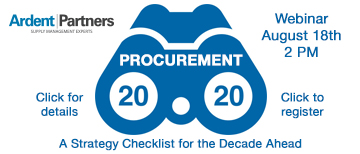The Rio 2016 Olympics are still going full throttle through this Sunday and I’ve been doing my best to watch as much as I can (how about those American swimmers from Maryland!!). This year, approximately 11,550 athletes representing teams from 205 countries plus two independent teams (Independent Olympic Team and the Refugee Olympic Team) traveled to Brazil to compete in 306 events across 28 different sports and 18 days. Many Olympians will have dedicated the majority of their lives to participate in an event that amazingly will take mere minutes, if not seconds, to complete. For these Olympians, it is said, that “the most important thing is not to win but to take part!”
In business, you are expected to win or die trying. Lose and face the consequence. This is true for Chief Procurement Officers and other leaders across the source-to-settle process – after all, there are no medals for 8th place or even 2nd place. CPOs don’t want participants, they want outcomes!
An ability to compete with the Best-in-Class for procurement gold takes practice, determination, and focus. Individuals and organizations must strive for greatness if they are to achieve it, or even begin to approach it. One game-changing strategy is to automate and link the entire source-to-settle process. If technology budgets today are not enough to get you there, start by manually, but holistically, linking your processes together – like the Olympic rings (sidebar: I believe that anytime you start adjusting your processes, you should invest significant effort trying to simplify them).
The majority of procurement teams today fail to link and automate their source-to-settle processes in a holistic fashion. Here are a few examples of what these enterprises experience, on average, by failing to close these gaps:
- Sourcing teams that fail to link spend analysis with their sourcing processes save significantly less on the average sourcing project
- Process gaps between the sourcing decision (i.e. contract award) and the final contract execution contributes to the savings leakage and a large gap between what procurement and finance count as savings
- The average enterprise pays almost 20 cents more for every dollar that is spent off-contract
- Enterprises without eProcurement pay twice as much for each PO and they have extraordinarily higher levels of maverick spend
- Non-PO invoices more to process, and those failing to deploy ePayables solutions across the A/P process can spend up to 90% more processing their invoices
While most procurement organizations are still in training mode, now is the time to set the goal to advance swifter, higher, and stronger across your processes and ascend to the procurement medal stand. If you’re going to play the procurement game anyway, you may as well give yourself the best chance to win.
Have fun, link your processes, and then, let your own games begin!
RELATED ARTICLES
What Can We Learn from the Golden State Warriors?
Monday Morning Query: What Makes an eSourcing Expert?
“Spring Training” Series: Contingent Workforce Management


